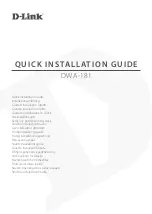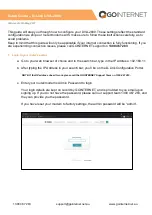
GARNET GAE-3020
12
2.7 Ethernet Router Configuration
There are multiple ways that routing can be set up depending on the
requirements from the service provider.
The following routing methods are described below:
•
••
•
IPoA Routing
•
••
•
PPP Routing
•
••
•
Routing using NAT (can be used with either IPoA or PPP)
2.8 IPoA Routing
When configured for IPoA, data is routed between Ethernet and Classical IP over
ATM (RFC1577). The IPoA data runs over a PVC between the modem and the
service provider. IP addresses, the PVC and the peak cell rate need to be defined
by the service provider. Since the modem is routing, an IP address needs to be
assigned on both modem’s interfaces. The PC’s default gateway must be set to
the Ethernet IP address of the modem. The following configuration must be
performed to set up the modem for the above example:
•
••
•
Add the Ethernet device to the router and assign it an IP address. In the
command, “ethernet” is a label used to refer to this device. The arguments
“ether” and “//edd” are required for an Ethernet device.
ip device add ethernet ether //edd 192.168.101.2
•
••
•
Add the IPoA device to the router and assign it an IP address. In the following
command, “ipoa” is a label used to refer to this device. The arguments “atmpvc”
and “//atm” are required for an IPoA device.
ip device add ipoa atmpvc //atm 192.168.102.2
•
••
•
Save configuration and reboot system. This is necessary when configuring
the system from the console, because the following commands can only operate
on router interfaces which have already been created.
config save
restart
•
••
•
Enable forwarding between the router interfaces:
ip relay all
•
••
•
Add a default route with the service provider as the gateway:








































